
Explore Zanzibar. (Photo: Getty Images)
Tips + TrendsFrom Lively Markets to Giant Tortoises (That Snap!) — Plan a Zanzibar Adventure
By Karen Dalton-BeninatoTropical Zanzibar, a fascinating mixture of the ancient and the offbeat, is where both the Swahili language and iconic rocker Freddie Mercury were born. To experience the island’s cultural riches far beyond a sedate beach vacation, buckle up and plan your own adventure, from exploring jungles and ruins to communing with century-old tortoises on their island sanctuary.
Play the Market(s)

For bulk spices, fresh fish, tropical produce and a wide variety of souvenirs, including printed African shawls, follow cobbled streets through Zanzibar City’s Stone Town to its popular bazaar, Darajani Market.
Browse through narrow stands that have drawn traders from around the world for centuries while listening for calls to prayer broadcast throughout the town. Follow your nose to nearby Zanzibar Coffee House, with its industrial-strength Tanzanian brew, and ask around for stories of Stone Town’s favorite son, Freddie Mercury, back when he was Farrokh Bulsara.
At dusk, hit the popular Forodhani Gardens food market along the seafront for a classic African street food dinner. Or order Zanzibar pizza, which is more like a massive crepe filled with your choice of ingredients and grilled. Local children provide free entertainment by competing with each other as they dive into the ocean from the low seawall wrapping around the promenade.
Visit Changuu Island — It’s a Snap

Ferry half an hour from central Zanzibar to visit the giant Aldabra tortoises and powder-white beaches of nearby Changuu Island. Better known as Prison Island, Changuu houses a prison and quarantine area built by sultans, which now lies in ruins.
Still, you’re more likely to remember this as “tortoise island” after feeding massive creatures gingerly enough not to get snapped at. The tortoises are friendly, but they move surprisingly fast considering some are over 100 years old and the largest of their species.
If you arrive at feeding time (10 a.m. and 4 p.m.), their caretakers will let you help feed them leafy greens, but be sure to take the caretakers’ advice on how close to get, and as always, keep your hand a safe distance from the tortoises’ snappers. Bring some tip money: You’ll be asked for a gratuity for feeding the tortoises.
The first few giant Aldabra tortoises were a gift to a sultan, and over the decades they’ve multiplied into a tribe of hundreds, complete with a team of caretakers. While on Prison Island, you’ll also be able to snorkel through pristine coral reefs with schools of tropical fish, if that’s up your alley.
Most guided tours run in the $40 range, including transportation and admission to the island, conservation fee and snorkeling gear. There’s also a small restaurant, if you could use cold drinks and a snack after watching tortoises nosh.
Spice It Up in the Groves

Cinnamon, nutmeg, cardamom, vanilla and other spices helped put Zanzibar on the map as part of the Spice Islands. Find the motherlode on a spice tour that brings you through lush groves and shows you how the plants are dried for seasoning and medicinal use.
One of the best parts of the tour is the chance to feast on an organic dinner made with the working farm’s exotic fruits and spices. Bring cash to purchase a spice stash of your own to bring home.
Journey into the Jungle
Head to south Zanzibar to explore walkways of Jozani Chwaka Bay National Park, and keep an eye out for the very rare, shaggy red colobus monkey, native to Zanzibar. Bring a camera with a quality zoom so you can keep at least a four-yard distance from the creatures — a necessity because they haven’t developed a resistance to many human ailments.
Entrance fee is $10 per person, and you’ll be assigned a guide when you enter the park (covered in the admission fee) to help you navigate the extensive jungle trails, so be sure to bring a tip.
Get Invigorated by Sea-Air Kitesurfing
Catch the fresh sea air while kitesurfing at Paje Beach on southeast Zanzibar. The northern beaches are far busier, so stick to Paje in the heat of December through February for less of the maddening crowd.
Rent your gear and book a lesson at Zanzibar Kite Paradise, a thatched-roof hut located right on the beach. At low tide, the waters recede so far out you’ll feel like you’ve reached world’s end. Paje Beach winds are calmer before lunch, so make like an islander and take your time getting there.
Afternoon winds will keep you flying high, and Kite Paradise offers one instructor for every two students, so you’ll get plenty of individual coaching. If you’re a first-timer or a nervous surfer, take comfort in knowing there’s also a rescue boat.







